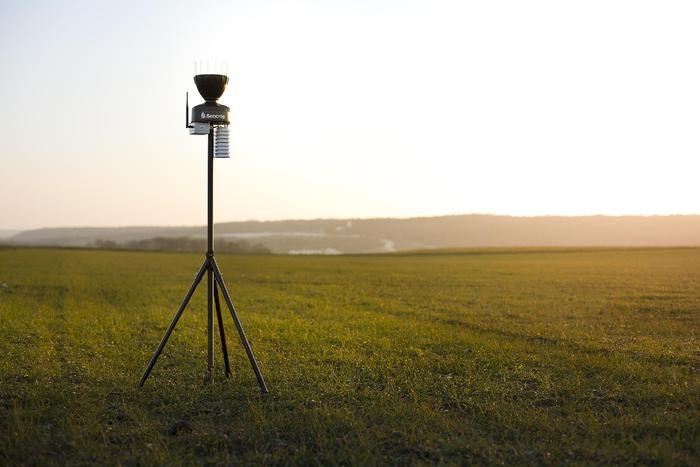
The UK’s largest water-only supply company is trialling a network of ‘smart’ on-farm weather stations in a bid to improve water quality at source.
Affinity Water has funded a network of Sencrop weather stations to help a group of Hertfordshire farmers improve decision-making in the application of pesticides and fertilisers.
Nearly 5,500ha of farmland supplies a number of water treatment works vulnerable to pollution.
The Mimmshall Brook and Upper River Colne, catchment areas designated by the Environment Agency as ‘Drinking Water Safeguard Zones’, are deemed at particular risk from metaldehyde, propyzamide and carbetamide.
By funding the network of Sencrop weather stations, which can measure both real time and anticipated rainfall as well as wind speeds, Affinity Water intends to support farmers by optimising the timing of their spraying operations involving these active substances.
Danny Coffey, Catchment Officer for Affinity Water, says all water companies are developing catchment-based solutions that can prevent pollution at source.
“It’s expensive and energy-intensive to remove pollutants from drinking water,” he explains, “so it’s more sustainable and more efficient to try to reduce levels in the first place.
“The Mimmshall Brook is particularly sensitive because it straddles both clay and chalk, allowing surface water to reach the groundwater – from which we abstract – very quickly.
“By working with farmers to develop and adopt a simple stewardship approach to the management of agronomically important actives, we aim to help them improve business efficiency while ensuring a clean and sustainable water supply for our customers.”
Mr Coffey hopes the network of ten Sencrop units, which will be complete by the end of January, will help farmers improve their decision-making around these key active substances.
“Propyzamide and carbetamide have very few viable alternatives,” Mr Coffey acknowledges, “but if we have to cease groundwater abstraction temporarily because of a spike in detected contaminants, we have no alternative but to import water from neighbouring areas, at significant expense.
“Much of this catchment area comprises the heavy clay soils favoured by black-grass, and we want to support farmers by providing additional technology and information to support the development of robust IPM plans that can incorporate more sustainable and effective use of these actives.
“We’re hoping that the weather insights provided by the Sencrop network will be a tool that will truly benefit our farmers and help them make more accurate, more timely spray applications.”
Mr Coffey discovered Sencrop’s smart weather stations during visits to Cereals and Groundswell. He said he was impressed by the app’s user-friendly interface and seven-day forecasting accuracy.
“It turned out that a lot of our farmers were already familiar with the Sencrop offering and were only too keen to participate in the trial,” he says.
“Although the networking feature was a later announcement, it will be a real benefit in allowing us and our users to see at a glance the differences in rainfall patterns and wind across the catchment areas.
“It will also benefit our contract-farming users, as they’ll have remote access to weather information from more distant sites.”
Mr Coffey says that while it will be difficult to attribute any direct effects on water quality improvement to the Sencrop network, it will be another valuable tool in helping farmers to manage their pesticide application timings which in turn could reduce losses to water.
“I’ve had nothing but positive feedback so far and I can already see the potential for this trial expanding within these catchments, and other areas too.
“Our farmers participate not only because they value stewardship of these important active ingredients, but because they care about their impact on the environment.”
Sencrop’s overall UK network now numbers more than 300 individual stations, while user numbers across Europe are now more than 10,000.
Fred South, Sencrop’s business manager, says the networking feature reflects the company’s ambition to provide user-friendly grower solutions, improving operational efficiency and optimising use of crop inputs.
“Crowd-sourcing weather and other farm data can, through analytics, deliver value, efficiency and environmental gains throughout the supply chain,” he says.
“While primarily improving the relevance and accuracy of weather forecasts for the individual grower.
“The network feature is a valuable addition to an already attractive package,” he says, “giving each individual user access to every station within the network, allowing them to make better, insight-led decisions about key agronomic operations.
“What’s more, farmers can join an existing network without installing a station themselves, paying only the subscription to access the app.”
